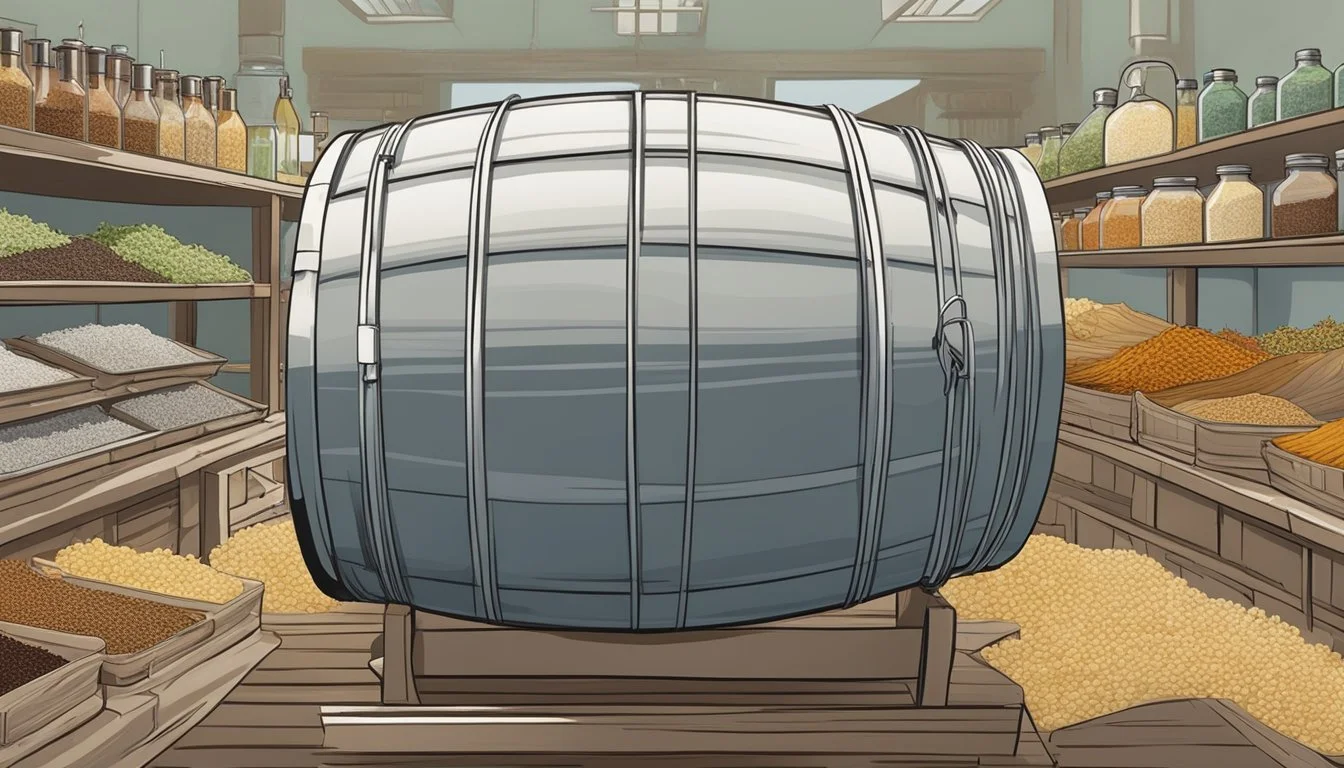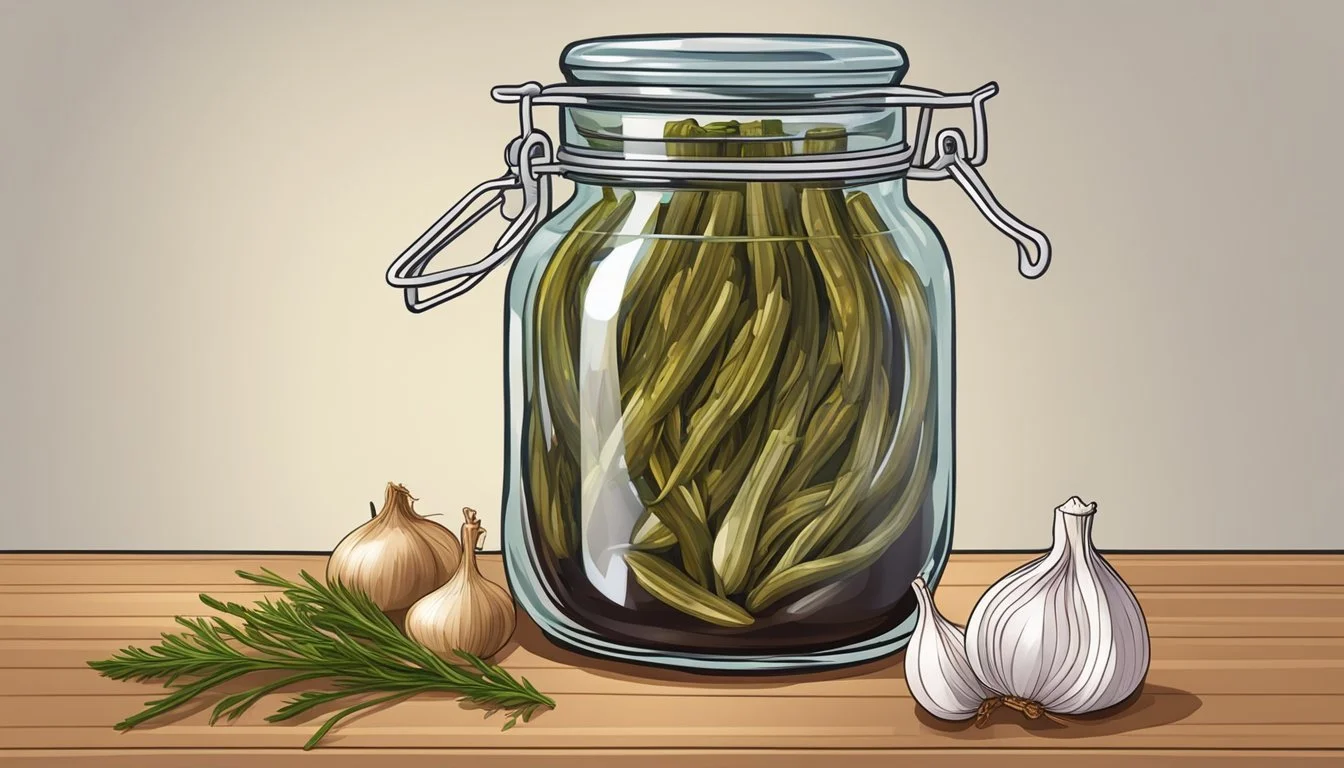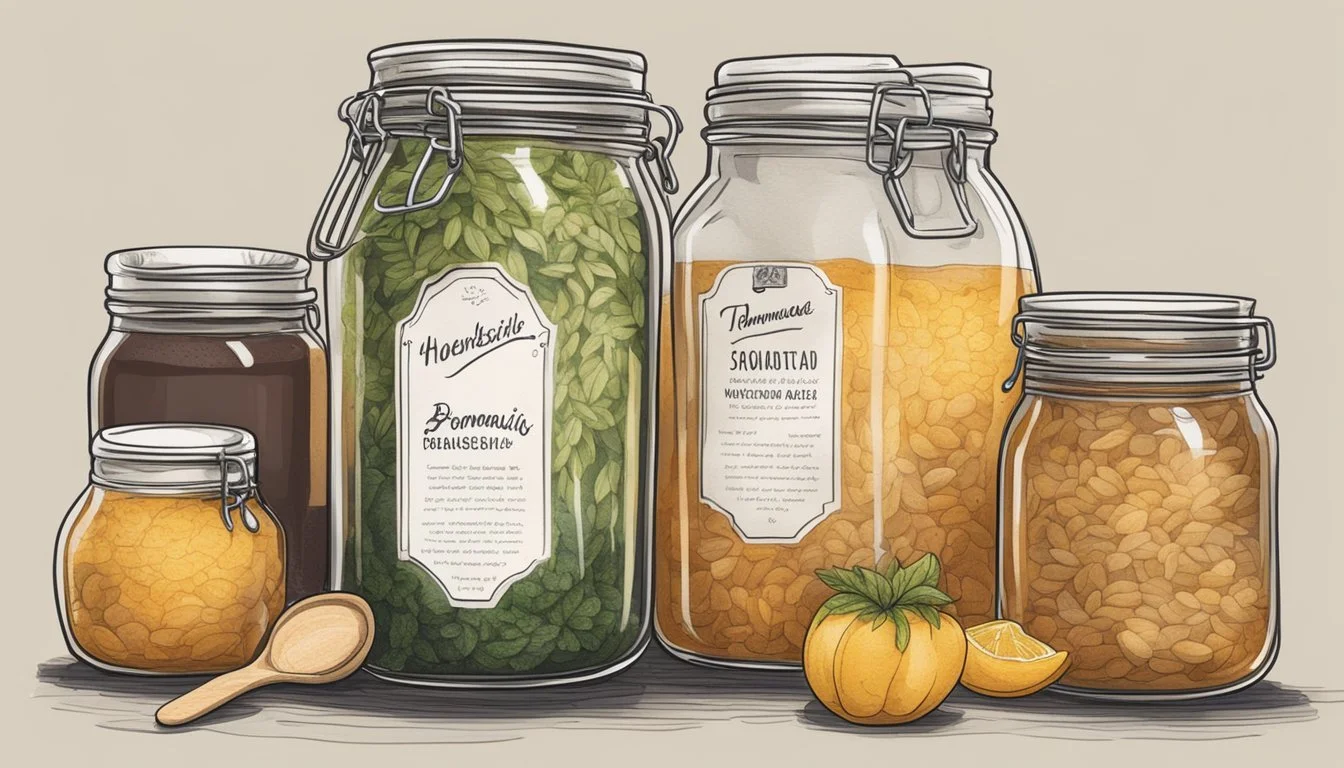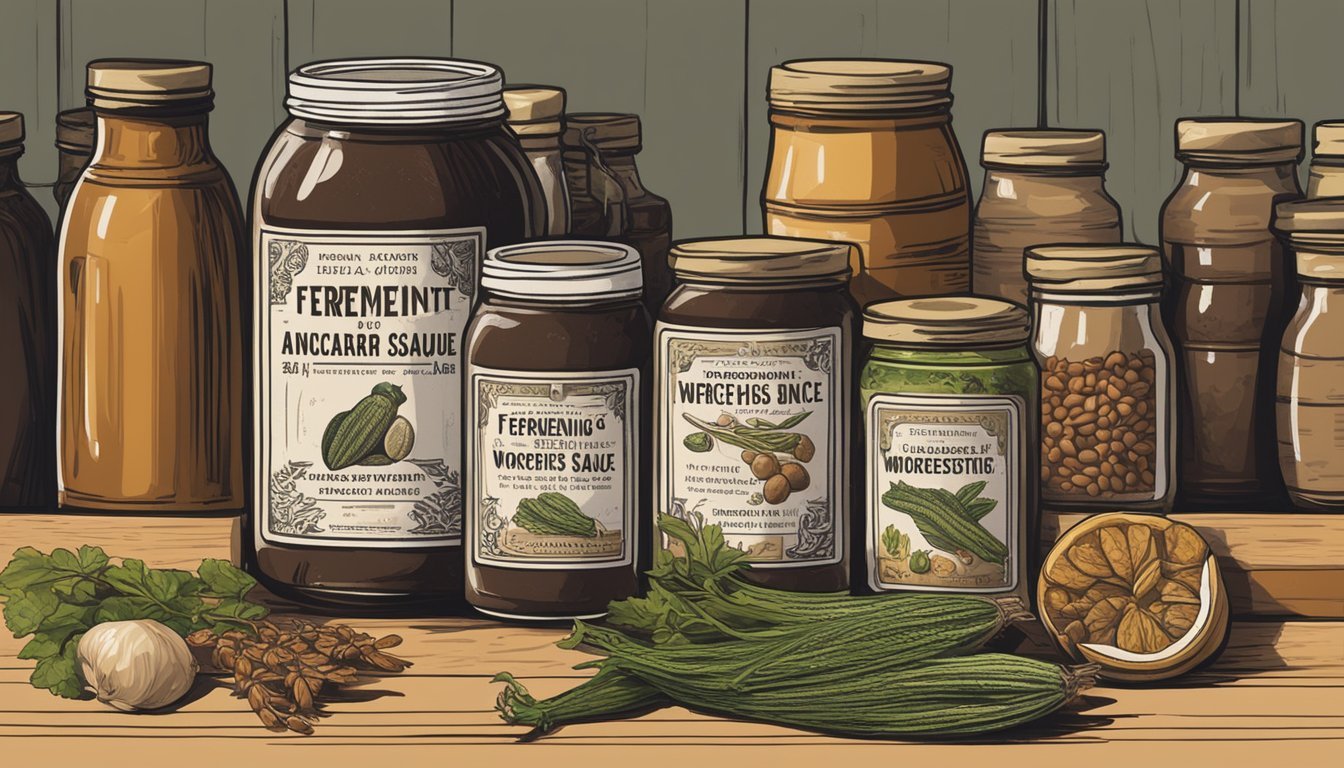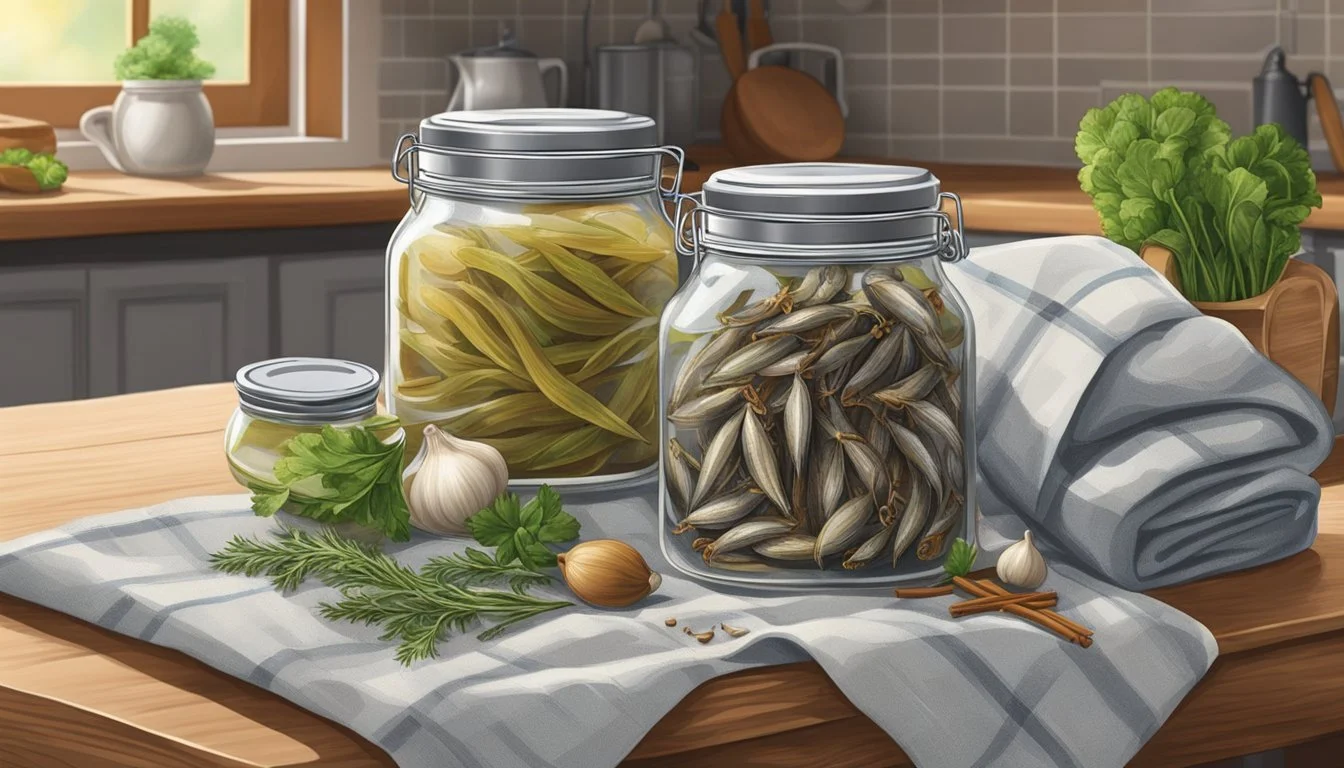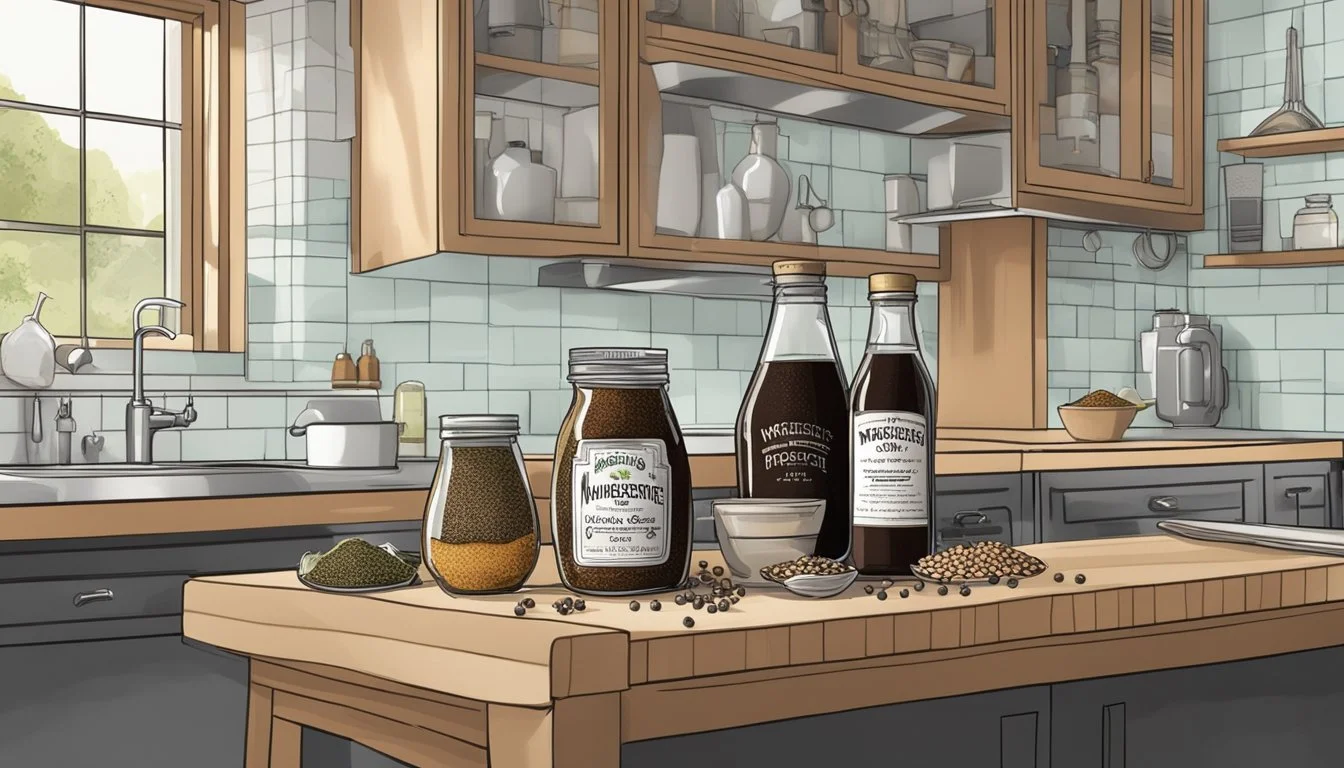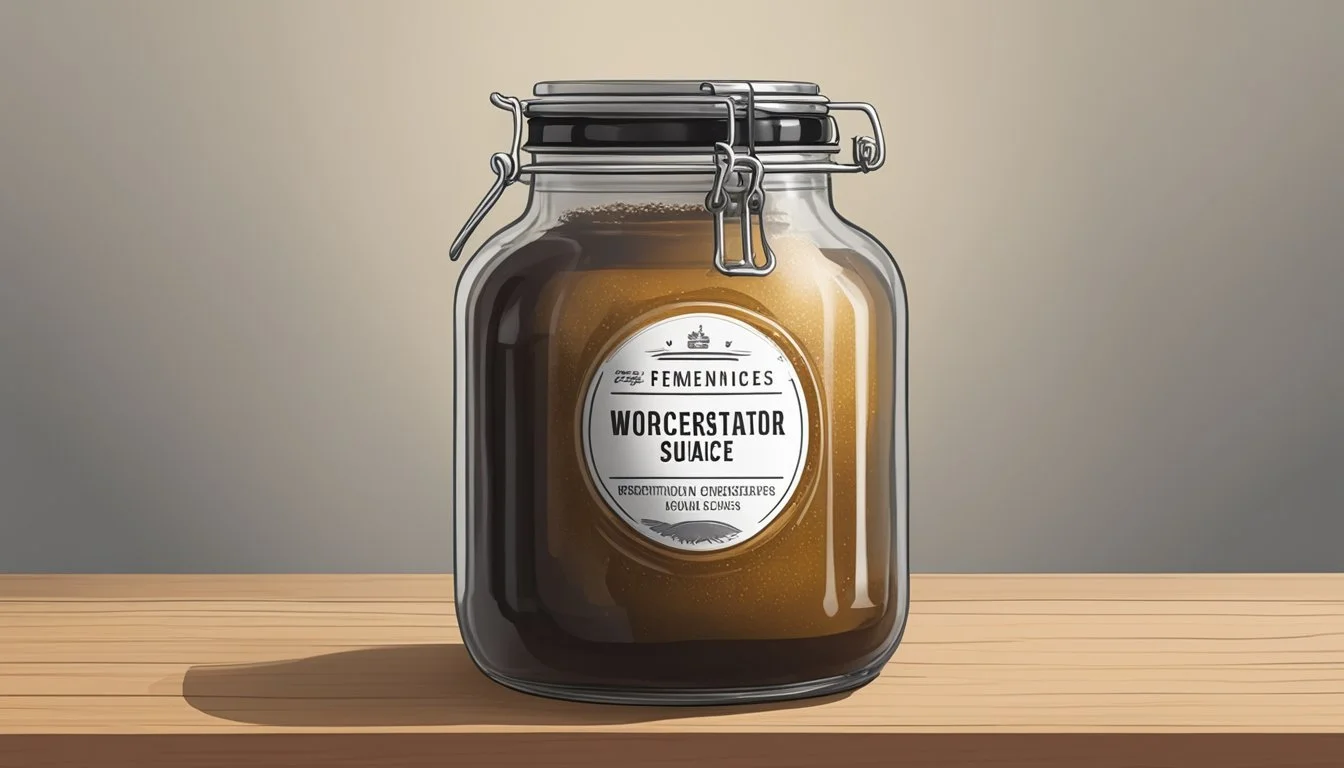How to Ferment Worcestershire Sauce
Mastering the Fermented Condiment Process
Worcestershire sauce is a staple in many kitchens, renowned for its complex flavor that enhances meat dishes, soups, and marinades. This fermented condiment originated in the city of Worcester, England in the 19th century. Its unique taste is the result of a long fermentation process that melds a variety of ingredients into a harmonious blend. Traditional recipes include ingredients like anchovies, (What wine goes well with anchovies?) tamarind, garlic (What wine goes well with garlic?), vinegar, molasses, onion, and a mixture of spices, though exact formulas can vary. These components undergo fermentation, which not only develops the sauce's distinctive flavor but also contributes to its longevity.
The process of fermenting Worcestershire sauce is intricate and requires patience, as it can take several months to achieve the desired depth of flavor. Ingredients are first combined, allowing the initial blend to ferment. After an initial period, which may last 18 months or more, the mixture is often refined, further aged, or diluted to reach the perfect consistency and taste before bottling. The result is a fermented condiment that is both rich in umami flavors and versatile in its applications.
While home cooks can embark on the process of creating their own Worcestershire sauce, it requires adherence to the principles of fermentation to ensure safety and quality. Commercially available Worcestershire sauce is carefully crafted to maintain consistent flavor and is typically sterilized for shelf stability. Whether incorporated into dishes as a cooking ingredient or used as a condiment, Worcestershire sauce remains a beloved addition to various cuisines across the globe.
History and Origin
Worcestershire sauce is a rich condiment with a storied past, originating from Worcestershire, England, and evolving from ancient fish-based sauces to the well-known Lea & Perrins brand.
From Roman Empire to Modern Times
Worcestershire sauce's lineage can be traced to the Roman Empire, where a fish sauce called garum played a significant role in their cuisine. This sauce was made from fermented fish and spices, laying the groundwork for similar condiments across various cultures. Centuries later, in England, this tradition was echoed in concoctions like Lord North's sauce and mushroom ketchup, precursors to the modern Worcestershire sauce.
The Creation by Lea and Perrins
In the first half of the 19th century, the city of Worcester in Worcestershire, England, witnessed the birth of the Worcestershire sauce we know today. John Wheeley Lea and William Henry Perrins, two pharmacists, developed the sauce by fermenting a blend of ingredients, including anchovies, tamarind, and spices. The exact recipe remains a closely guarded trademark of the Lea & Perrins company. It is rumored that the recipe was commissioned by Lord Marcus Sandys, a nobleman of the area, after his return from Bengal. The sauce was commercialized and became hugely popular, with the Lea & Perrins factory in Birmingham playing a pivotal role in its distribution.
Fundamentals of Fermentation
In the process of creating fermented condiments like Worcestershire sauce, the interplay of microbes and food science is essential, and the end product is rich in flavors and potential health benefits.
Science Behind Fermentation
Fermentation is the metabolic process in which natural bacteria, yeasts, or fungi convert carbohydrates, such as starch and sugar, into alcohol or acids. These microorganisms initiate the fermentation process by breaking down the food components, which results in the preservation of the food and the development of a rich, complex flavor profile, characterized by the savory taste known as umami. In the instance of Worcestershire sauce, ingredients like anchovies are broken down, alongside a blend of vinegar and spices, which are then allowed to ferment over time. This extended aging period contributes to the deep, distinct taste and the sauce's liquid consistency.
Fermented foods, including Worcestershire sauce, typically undergo an aging or curing process that can last several months to several years, allowing for the development of the desired flavors and textures. The conditions under which fermentation takes place are crucial; factors such as temperature, time, and salinity must be carefully controlled to prevent spoilage and ensure safety.
Health Benefits of Fermented Foods
Fermented foods like Worcestershire sauce can be a source of health benefits due to the presence of probiotics, which are beneficial bacteria that can aid in digestion and overall gut health. While Worcestershire sauce is not a primary source of nutrients, it features trace amounts of vitamins and minerals that can contribute to a nutritious diet.
Vitamins: Small concentrations of vitamins such as thiamin, riboflavin, and vitamin C may be found in the sauce.
Probiotics: The fermentation process can promote the growth of probiotics, although Worcestershire sauce is typically pasteurized, which reduces these bacteria.
Consuming a variety of fermented foods can add to the dietary diversity, offering different types of probiotics and subtle flavors to dishes. It is worth noting, however, that moderation is key, as condiments like Worcestershire sauce are often high in sodium.
Ingredients Breakdown
In crafting Worcestershire sauce, each ingredient serves a crucial role in developing the sauce’s complex flavor and ensuring proper fermentation. This breakdown will explore the primary components and their specific contributions to the concoction.
Primary Components
Anchovies: A source of umami, anchovies are salt-cured, contributing to the depth of flavor and acting as a preservative.
Tamarind: Imparts a fruity acidity that complements the overall savory profile.
Vinegar: Vinegars, like apple cider vinegar and malt vinegar, provide acidity necessary for fermentation and flavor development.
Molasses: Adds sweetness and color, balancing the tang from vinegar and saltiness from anchovies.
Garlic: Enhances the sauce’s aroma and provides a subtle pungency.
Onion: Brings a foundational flavor that supports the complex profile.
Salt: Essential for flavor enhancement and acts as another preservative.
Spices: Commonly include clove and others, contributing warmth and spice notes.
Sugar: Sometimes used for additional sweetness, balancing out the acidity and salt.
Water: Serves as a base for dissolving and integrating ingredients.
Role of Each Ingredient
Salt-cured Anchovies: Initiate the fermenting process by providing beneficial bacteria and adding a distinct savory flavor.
Tamarind: Its acidity complements vinegar, aiding fermentation, while its sweetness tempers the sauce's savory elements.
Apple Cider and Malt Vinegar: Both types of vinegar act as fermentation agents and flavor enhancers, with cider vinegar adding a mild fruitiness and malt vinegar bringing a robust tang.
Molasses: This sweetener enriches the sauce's color and texture while counteracting the harshness of the vinegar.
Garlic and Onion: These aromatics offer depth, creating a robust base for the other flavors to build upon.
Cloves and other spices: Contribute complexity and a subtle heat, rounding out the sauce's profile.
Sugar: Optional, for fine-tuning sweetness and providing a counterpoint to the more potent flavor elements.
Water: Dilutes the mixture to the desired consistency and ensures even distribution of flavors across the entire batch.
Homemade Worcestershire Sauce
Creating homemade Worcestershire sauce involves combining a variety of ingredients to achieve its unique, fermented flavor. Homemade versions can match the depth and complexity of store-bought sauces through careful preparation and ingredient selection.
Preparation Overview
The initial step is to assemble all necessary ingredients. One requires tamarind extract or paste to impart a characteristic sourness, while shallots and garlic cloves offer pungent undertones. Fresh ginger and an assortment of dried spices, such as black pepper and cardamom pods, provide a warm spice profile. A balance of sweetness and umami is introduced through raisins, brown sugar, soy sauce, and fish sauce. Distilled white vinegar adds a tangy, acidic component crucial to the sauce's preservation and taste.
Cooking Steps and Duration
Begin by softening tamarind paste in boiling water for about an hour; this becomes the base flavor.
In a saucepan, combine finely minced shallots, garlic, and grated ginger with softened tamarind, raisins, and brown sugar, enhancing the mixture's complexity.
Add soy sauce, fish sauce, distilled white vinegar, and dry spices like ground black pepper and crushed cardamom to the saucepan.
Simmer the concoction over medium-low heat for approximately 15 minutes, allowing the flavors to meld together.
The sauce should be stirred occasionally for uniformity. Once cooked, let it cool and then blend until smooth. The total cooking time is around 1.5 hours including preparation.
Ingredient Alternatives
For those with dietary restrictions or preferences, there are various ingredient substitutions available:
Tamarind Extract: If unavailable, a mix of equal parts lime juice and brown sugar can be used.
Soy Sauce: Tamari or coconut aminos offer gluten-free alternatives.
Fish Sauce: Kombu (dried kelp) steeped in water provides a vegan umami flavor.
These alternatives can serve to adjust the sauce to individual tastes or dietary needs, allowing for a flexible approach to this classic condiment.
Flavor and Culinary Uses
Worcestershire sauce is renowned for its complex flavor profile and versatility in the kitchen, enhancing dishes with its unique blend of umami, savory, and tangy notes. This section delves into the nuances of its taste and the various ways it can be incorporated into culinary creations.
Taste Profile of Worcestershire Sauce
The flavor of Worcestershire sauce is multi-dimensional. It is primarily umami, which can be described as a savory taste intrinsic to ingredients like anchovies that form its base. It also possesses a distinct salty component, balanced with a subtle sweetness from ingredients such as molasses. Its tartness, coming from tamarind and vinegar, adds a bright note to the sauce's profile. This intricate combination makes Worcestershire sauce a pantry staple for adding depth to a wide variety of dishes.
Common Food Pairings and Recipes
Worcestershire sauce pairs well with an array of foods and is an essential ingredient in countless recipes. Here are several ways it can be used:
Marinades: For meats like beef, veal, or chicken, Worcestershire sauce provides a rich base for marinades, tenderizing the meat while infusing it with flavor.
Seasoning: A dash can enhance the savory qualities of soups and stews, especially beef stew. (What wine goes well with beef stew?)
Barbecue Sauce: It serves as a key ingredient in barbecue sauces, giving them a distinct tang.
Dressings and Dips: Worcesterhire sauce can enliven salad dressings and dipping sauces, imparting an umami punch.
Soups and Stews: A splash can deepen the flavors of various soups and stews.
Spread for Bread: It can be mixed into butters or soft cheeses for a flavorful bread spread.
Steaks: Just a few drops on a steak before cooking can highlight the meat's savory qualities.
Whether used as a condiment, in marinading, or as part of a dressing or dipping sauce, the versatility of Worcestershire sauce makes it indispensable in kitchens around the world. Its usage elevates simple recipes into gourmet dishes.
Worcestershire Sauce Variations
While traditional Worcestershire sauce has a distinctive flavour profile, various regions and dietary needs have inspired numerous adaptations. These versions cater to specific tastes and restrictions while retaining the essence of the original condiment.
Regional Variations
Different regions have created their spin on Worcestershire sauce, often using local ingredients to achieve a unique twist. In some Asian countries, for instance, tamari might be used in place of the standard soy sauce or fish sauce to impart a richer, deeper flavor and to maintain a gluten-free recipe. Alternatives like apple cider vinegar can also be employed to adjust the tanginess or to complement local taste preferences.
Japan: Utilizes tamari, offering a gluten-free and deeper umami flavor
United States: Might include apple as a sweet-tart component
Special Dietary Versions
Adaptations for special diets have become essential to suit the needs of individuals following vegan, vegetarian, or gluten-free diets.
Vegan Worcestershire Sauce: Made without anchovies, this version often uses seaweed or tamarind to mimic the umami taste.
Gluten-Free: Replaces any wheat-containing ingredients, like malt vinegar, with gluten-free options such as white vinegar or apple cider vinegar.
Vegetarian: Similar to vegan versions but may include honey or other non-vegan sweeteners.
Vegan: No anchovies, seaweed or tamarind used - To provide umami flavor without using animal products
Gluten-Free: Tamari instead of soy sauce, apple cider vinegar - To eliminate gluten without compromising taste
Vegetarian: Seaweed or tamarind, possibly honey - To achieve depth of flavor without animal-derived fish sauce
Storage and Preservation
Ensuring the longevity of homemade fermented Worcestershire sauce requires attention to bottling methods and adherence to optimal storage conditions. Using the correct techniques ensures both safety and flavor preservation over time.
Bottling and Packaging
Before storing fermented Worcestershire sauce, it must be transferred to an appropriate container. Glass bottles are preferred due to their non-reactive nature and capability to preserve the sauce's flavor without leaching. After filling the bottle, it is crucial to create an airtight seal to prevent contamination and oxidation. Using a clean funnel, the sauce is poured into the bottle, leaving a small headspace to allow for any expansion.
Shelf Life and Storage Conditions
The shelf life of homemade Worcestershire sauce largely depends on the storage conditions. Refrigeration is recommended to significantly extend the sauce's lifespan. Ideally, the sauce should be kept in a cool storage area, maintaining a consistent temperature between 60 to 65°F (16 to 18°C). A dark place, such as a cupboard or a pantry, protects the sauce from light which could degrade its quality. Properly sealed and stored, the sauce can last for several months, with its flavor developing over time. Regular checks for spoilage are important to ensure the sauce remains safe to consume.
Pairings and Mixology
Worcestershire sauce is renowned for its complex flavor profile that enhances a variety of dishes and drinks. It is a key ingredient in both classic food pairings and inventive cocktail recipes.
Classic Food Pairings
Worcestershire sauce possesses a unique blend of tangy, umami, and slightly sweet flavors, making it a versatile condiment for food pairings. It complements beef excellently, acting as a savory boost for burgers and steaks. Moreover, Worcestershire sauce elevates simple cheese dishes, such as cheese on toast or a cheese platter, adding depth with its fermented notes.
Beef: Burgers, steaks, meatloaf
Cheese: Grilled cheese sandwiches, cheese dips
Worcestershire Sauce in Cocktails
In the realm of mixology, Worcestershire sauce is a cornerstone for the iconic Bloody Mary cocktail. The sauce's rich flavor intertwines with the tomato base and ginger undertones, creating a multidimensional and robust drink.
Bloody Mary: Combines tomato juice, vodka, Worcestershire sauce, other spices
Other Cocktails: May be used sparingly to add a savory note to certain whiskey or rum-based drinks
When used in cocktails, one should balance the pungency of the sauce with the other ingredients to ensure it complements rather than overpowers the beverage.
Nutritional Information
Worcestershire sauce, known for its rich umami flavor, presents a unique profile of nutrients that can contribute to a person's dietary requirements in small amounts, despite not being a significant source of nutrition.
Macro and Micro Nutrients
Worcestershire sauce contains trace amounts of macro and micro nutrients. Notably, it has small quantities of vitamins such as thiamin, riboflavin, and vitamin C, along with minerals like iron, magnesium, zinc, and copper. These can be beneficial for health when incorporated into a balanced diet.
Calories: Low in calories, Worcestershire sauce offers about 15 calories per tablespoon.
Sodium: It is high in sodium, with around 150mg per teaspoon.
Sugar: This condiment typically contains sugar, but the amount is minimal, contributing marginally to the total caloric intake.
Dietary Impact
The ingredients in Worcestershire sauce, such as vinegar and sugar, along with its fermentation process, contribute to both its flavor profile and nutritional value.
Health: Due to its fermentation, Worcestershire sauce can be part of a healthy diet if used in moderation, considering its high sodium content.
Umami: The savory taste of Worcestershire sauce, resulting from its umami, is due to the presence of amino acids from its fermented components, which do not add nutritional value but impact diet through flavor enhancement.
In summary, while Worcestershire sauce can provide minute amounts of essential nutrients and enhance flavors due to its unique contents and fermentation process, it should be consumed in moderation because of its high sodium content.
Culinary Techniques
Incorporating Worcestershire sauce into recipes enhances the flavor profile of dishes with its complex blend of savory, sweet, and tangy elements. Chefs often regard this condiment as an essential component in their culinary toolkit for its ability to transform the taste of various preparations.
Incorporating Worcestershire Sauce into Cooking
One popular application of Worcestershire sauce is in marinades, where its acidic components help tenderize meats while imparting a depth of flavor. To use in a marinade, chefs might combine:
1/4 cup Worcestershire sauce
1/2 cup olive oil
2 tablespoons lemon juice or vinegar
Seasonings such as garlic, pepper, and salt
When used in barbecue sauces, Worcestershire sauce adds a rich umami base that complements the smokey, sweet, and acidic notes commonly found in these preparations. A basic barbecue sauce incorporating Worcestershire might look like:
- 1 cup ketchup
- 1/4 cup Worcestershire sauce
- 1/4 cup brown sugar
- Seasonings (e.g., smoked paprika, garlic powder)This sauce can be simmered until thickened for brushing onto meats during the last stages of cooking or used as a dipping sauce.
Advanced Uses in Gourmet Dishes
In the realm of gourmet cooking, Worcestershire sauce has its place as a key component in complex sauces and dressings. Its multifaceted flavor can complement and enhance elements within the dish. For instance:
In Caesar dressing, Worcestershire sauce provides an anchovy-tinged zest that elevates the dressing beyond the sum of its parts.
For refined beef dishes, a few dashes of Worcestershire can enrich gravies and pan sauces, imbuing them with a level of sophistication.
Chefs may craft their own versions of Worcestershire sauce as well, tailoring it to specific dishes and making the condiment a true art in culinary art.
When applied with precision, Worcestershire sauce asserts itself as a versatile player in culinary techniques, capable of both subtle background roles and distinct flavor contributions.
Industrial Production
The production of Worcestershire sauce on an industrial scale involves complex processes and rigorous quality control measures to ensure the achieving of trademark flavors, consistent quality, and the ability to produce at high volumes as demanded by commercial markets.
Manufacturing Processes
Industrial production of Worcestershire sauce typically starts with the preparation of a base composed of vinegar, molasses, sugar, salt, anchovies, tamarind extract, onions, (What wine goes well with onions?) garlic, and other seasonings. The exact recipe and proportions are often a closely guarded secret, varying between brands. Lea & Perrins Worcestershire Sauce, a leading brand, is known for its unique blend of ingredients and its fermentation process, which significantly contributes to its distinct taste.
The mixture undergoes a fermentation period, which can last for several months. Throughout this time, the sauce develops its complex flavors. In this phase, manufacturers frequently engage in industrial scaling, utilizing large fermentation vats that allow production to keep up with commercial demands. Once the fermentation period is complete, the sauce is filtered, refined, and sometimes pasteurized to both clarify the sauce and stabilize its flavors.
Quality Control
To maintain a high level of product consistency and quality assurance, the industrial production process incorporates multiple quality control checkpoints. Samples from each batch are tested for various parameters including:
pH levels
Specific gravity
Viscosity
Flavor profile
Color consistency
The results must adhere to stringent standards set by the brand's quality assurance protocols as well as food safety regulations. Any deviation might mean adjusting the production process or, in some cases, disposing of the batch.
Traceability is another crucial aspect of quality control, ensuring that every bottle can be traced back to its production batch. Reliable traceability defends against contamination risks and upholds the trademark standards expected from established Worcestershire sauce brands.
Cultural and Historical Significance
The legacy of Worcestershire sauce is deeply rooted in British tradition and extends its influence across global cuisines, becoming an integral component in the culinary practices of diverse cultures.
Worcestershire Sauce in British Culture
In England, where Worcestershire sauce originated, it has been an enduring kitchen staple since the 19th century. This fermented condiment was first concocted by John Wheeley Lea and William Henry Perrins, pharmacists from the city of Worcester in Worcestershire. British culture has embraced this sauce in various traditional dishes, highlighting its cultural significance. British households often use it to enhance the flavor profiles of meals, from Bloody Marys and Caesar salads to steaks and cheeses.
Global Influence and Adaptation
Worcestershire sauce's global journey has led to its adoption into various national cuisines, attesting to its versatility and universal appeal. In the United States, it is a common ingredient in Bloody Mary cocktails and barbecue rubs. India incorporates it into colonial-inspired curries and marinades, reflecting the fusion of British and Indian flavors. Thai cuisine too has found uses for this ferment, integrating it into their own spicy and savory dishes, thus enriching the landscape of global cuisine. Across these cultures, Worcestershire sauce represents a transcendent add-on that adapts to regional tastes while maintaining its core identity.
Regulatory Considerations
When producing and selling Worcestershire sauce, manufacturers must adhere to specific guidelines that govern labeling and branding. These guidelines aim to ensure product quality, consumer safety, and fair trade practices.
Labeling Laws and Nutrition Facts
Regulatory agencies such as the Food and Drug Administration (FDA) in the United States stipulate strict labeling requirements for fermented foods, including Worcestershire sauce. Labels must provide accurate nutrition facts, including serving size, calorie content, and details of nutrients such as vitamins and minerals. Health claims on labels are closely monitored to prevent misleading information.
Required Nutrition Information:
Serving Size
Calories
Amount of Fat, Sodium, Carbohydrates, Protein
Percent Daily Values
It is imperative that all labels reflect the actual contents of the product, and any allergens, such as fish (often used in Worcestershire sauce), must be clearly indicated.
Trademarks and Branding
The name "Worcestershire" is associated with the original sauce produced by Lea & Perrins. Intellectual property laws protect such branding, ensuring that only products that meet certain standards can use the name. Trademarks help consumers identify authentic products and prevent misuse of the brand name by other entities. Worcestershire sauce producers must respect these trademarks to avoid legal repercussions and to maintain the integrity of their own brands.
Key Branding Elements:
Product Name (subject to trademark)
Company Name
Logo
Regulations ensure fair competition and prevent the market from being flooded with imitations that could dilute brand value and confuse consumers. Manufacturers must navigate these regulatory frameworks effectively to ensure compliance and protect their product identity.
Frequently Asked Questions
This section addresses common queries and provides practical advice on homemade Worcestershire sauce, offering solutions for troubleshooting during fermentation and suggesting alternatives for ingredients or variations in recipes.
DIY Troubleshooting
Issue: Sauce isn't fermenting.
Solution: Ensure the temperature is consistent and warm enough to encourage fermentation. Typically, a temperature between 55°F and 75°F is ideal.
Issue: Mold on the surface.
Solution: Skim off the mold; it often doesn't affect the sauce underneath. To prevent mold, ensure all equipment is sterile before use and that the sauce is adequately covered.
Issue: Sauce is too thin.
Solution: Extend the fermentation time to allow further reduction or add a thickening agent like a small amount of cornstarch dissolved in water.
Issue: Flavor is too mild or too strong.
Solution: Adjust the length of fermentation or modify the quantity of potent ingredients like tamarind or anchovies.
Substitutes and Alternatives
Soy sauce: A common substitute for the umami flavor; use in a 1:1 ratio.
Tamarind concentrate: An alternative to tamarind paste; it's stronger, so use half the amount the recipe calls for tamarind paste.
Molasses and Sugar-Free Variations:
Avoid molasses for a sugar-free version by using stevia or another sugar substitute, but start with small amounts and adjust to taste.
Vegan Worcestershire Sauce: Replace anchovies with a mixture of dried seaweed or miso paste to mimic the umami flavor.
Storage Alternatives:
Keep the sauce in a cool, dark place during fermentation.
Once bottled, store in the refrigerator to maintain quality for up to three months after opening.
By considering these tips and alternatives, one can successfully create and customize their Worcestershire sauce to suit individual tastes and dietary requirements.
Conclusion
Fermentation transforms simple ingredients into Worcestershire sauce, a condiment with a rich, umami flavor profile. In summary, the process begins with layering the base ingredients such as onions, garlic, and anchovies, allowing them to ferment. The anchovies are cured in salt, fusing with the malt vinegar where onions and garlic are also packed. These ingredients undergo an extended fermentation period.
Worcestershire sauce's unique taste comes from the precise mixture of tamarind, molasses, and a blend of spices, augmenting the initial fermented concoction. The aged mix is then carefully diluted and sterilized, ensuring the sauce is safe for consumption before it is bottled.
This sauce, though not a significant source of nutrients, does provide modest amounts of certain vitamins. When introduced to meals, it adds not just flavor but a slight nutritional boost.
The history of Worcestershire sauce involves accidental aging that resulted in its popularization. The unwanted initial batch created by Lea and Perrins ultimately gained acclaim due to the unexpected fermentation.
In their kitchens, enthusiasts can mimic this process to produce a homemade version, though the exact flavor may vary due to proprietary blends used commercially. Regardless, the rich history behind Worcestershire sauce and its intricate production process underline its status as a staple in kitchens worldwide.

